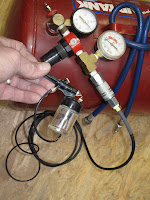
The rudder pedals are reassembled and ready to install once I find the missing center bearing block.
.
.
.
.
.
.
.

The bearing is a cast part. split in half with 2 holes for the tubes. The part number 0411264 is cast on the side of each half. The Top is -3 and the bottom-4. I'm missing the bottom. From the parts I have I can't tell that they were machined as pairs since all the halves line up well. It's obvious from wear marks which were the installed pairs, but otherwise there is no misalignment. Therefore if I could find even just a bottom it would probably work.
.
.

These springs are the rudder pedal return springs which keep the pedals from falling toward the seats. They were a little rusty and at some time after the factory slobbered with paint. It was quicker to clean them up and epoxy
prime them then look for new ones. I stretched them, between some clamps, enough to hold them open to grit blast and prime them. Once they are well cured I'll release them and they'll be ready to install with the pedals.
The next job is the brake master cylinders.
 The rudder pedals are reassembled and ready to install once I find the missing center bearing block.
.
.
.
.
.
.
.
The rudder pedals are reassembled and ready to install once I find the missing center bearing block.
.
.
.
.
.
.
.
 The bearing is a cast part. split in half with 2 holes for the tubes. The part number 0411264 is cast on the side of each half. The Top is -3 and the bottom-4. I'm missing the bottom. From the parts I have I can't tell that they were machined as pairs since all the halves line up well. It's obvious from wear marks which were the installed pairs, but otherwise there is no misalignment. Therefore if I could find even just a bottom it would probably work.
.
.
The bearing is a cast part. split in half with 2 holes for the tubes. The part number 0411264 is cast on the side of each half. The Top is -3 and the bottom-4. I'm missing the bottom. From the parts I have I can't tell that they were machined as pairs since all the halves line up well. It's obvious from wear marks which were the installed pairs, but otherwise there is no misalignment. Therefore if I could find even just a bottom it would probably work.
.
. These springs are the rudder pedal return springs which keep the pedals from falling toward the seats. They were a little rusty and at some time after the factory slobbered with paint. It was quicker to clean them up and epoxy prime them then look for new ones. I stretched them, between some clamps, enough to hold them open to grit blast and prime them. Once they are well cured I'll release them and they'll be ready to install with the pedals.
The next job is the brake master cylinders.
These springs are the rudder pedal return springs which keep the pedals from falling toward the seats. They were a little rusty and at some time after the factory slobbered with paint. It was quicker to clean them up and epoxy prime them then look for new ones. I stretched them, between some clamps, enough to hold them open to grit blast and prime them. Once they are well cured I'll release them and they'll be ready to install with the pedals.
The next job is the brake master cylinders.






